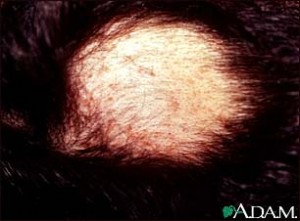Alternate Names : Alopecia totalis, Alopecia universalis
Definition
Alopecia areata is a condition that causes round patches of hair loss.
Overview, Causes, & Risk Factors
The cause of alopecia areata is unknown. About a fifth of people with this condition have a family history of alopecia. Alopecia areata may sometimes occur with autoimmune diseases.
Forms of alopecia include:
* Alopecia totalis — complete loss of scalp hair
* Alopecia universalis — total loss of all body hair
Pictures & Images
Alopecia areata with pustules
Pus-filled lesions (pustules) are unusual in alopecia areata, but can occur, as in this picture. The pustules are infected where medication was injected into the area.
Alopecia totalis – back view of the head

Hair loss is referred to as alopecia. Patchy hair loss on the scalp is called alopecia areata. Complete scalp hair loss is alopecia totalis. Loss of all body hair is called alopecia universalis.
Alopecia totalis – front view of the head

Hair loss is referred to as alopecia. Patchy hair loss on the scalp is called alopecia areata. Complete scalp hair loss is alopecia totalis. Hair loss from the entire body, including the eyebrows, eyelashes, and body hair, is alopecia universalis.
Alopecia, under treatment

This picture shows alopecia areata, under treatment. The hair loss is being treated with anthralin, which causes the brownish hyperpigmentation and can induce hair regrowth. It is very unlikely regrowth will occur when hair is lost along the scalp margin (ophiasis).
Alopecia areata: Overview, Causes
Alopecia areata: Symptoms & Signs, Diagnosis & Tests
Alopecia areata: Treatment
Reviewed By : Kevin Berman, MD, PhD, Atlanta Center for Dermatologic Disease, Atlanta, GA. Review provided by VeriMed Healthcare Network. Also reviewed by David Zieve, MD, MHA, Medical Director, A.D.A.M., Inc.

